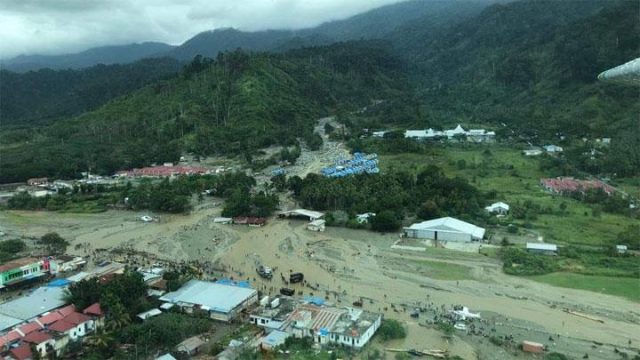19 March 2019
Sentani, Indonesia: at least 89 killed in rainfall induced debris flows
Posted by Dave Petley
Sentani, Indonesia: at least 89 killed in rainfall induced debris flows
On Saturday, heavy rainfall in the Sentani area of Papua region of Indonesia triggered landslides and debris flows that are known to have killed at least 89 people, with reports suggesting that at least another 74 people are missing. Reports suggest that 159 people have been injured. Whilst seven of the fatalities are reported to have been in a landslide event at Ampera in Jayapura City, most of the remainder of the losses are ascribed to “flash floods”. However, photographs from the site clearly indicate that these events were channelised debris flows. For example, this appears to have been the largest event, which occurred close to the airport:-

The aftermath of the channelised debris flows at Santani in Papua, Indonesia. Image via Bisnis.tempo.co.
.
This image provides a different perspective on the same site:

The aftermath of the debris flows at Sentani in Papua, Indonesia. Image via radarcirebon.
.
Some reports indicate that this area received about 250 mm of rainfall in seven hours. There are also suggestions that deforestation in the mountains may also have played a significant role. But as is so often the case, the major issue appears to be the construction of houses on natural alluvial fans, built by successive debris flow events. Note in the image above the way in which the flow has passed directly through the housing development with blue roofing. The river channel is just to the left but flows naturally migrate across fans during large events.
As numerous videos have shown, channelised debris flows are very energetic events, which most residential structures are unable to resist. The answer to these events is to try to ensure that these hazardous areas are not occupied, at least during intense rainfall; to protect properties that are in dangerous locations; and, of course, to try to ensure that catchments are managed properly.


 Dave Petley is the Vice-Chancellor of the University of Hull in the United Kingdom. His blog provides commentary and analysis of landslide events occurring worldwide, including the landslides themselves, latest research, and conferences and meetings.
Dave Petley is the Vice-Chancellor of the University of Hull in the United Kingdom. His blog provides commentary and analysis of landslide events occurring worldwide, including the landslides themselves, latest research, and conferences and meetings.